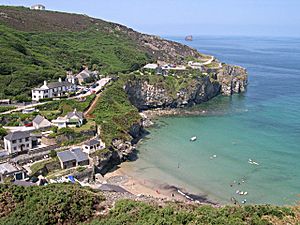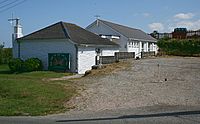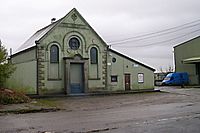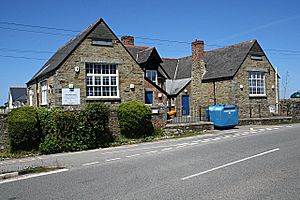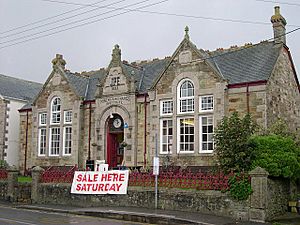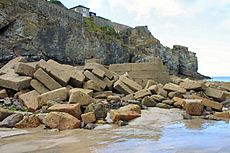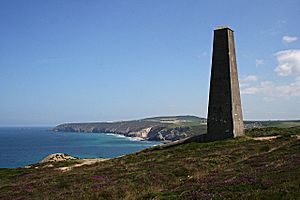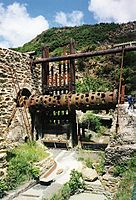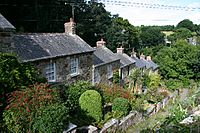St Agnes, Cornwall facts for kids
Quick facts for kids St Agnes
|
|
|---|---|
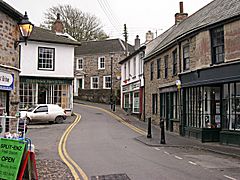 Churchtown, St Agnes |
|
| Lua error in Module:Location_map at line 530: Unable to find the specified location map definition: "Module:Location map/data/Cornwall (mainland)" does not exist. | |
| Population | 7,565 Parish 7,565 including Cross Coombe and Manor Parsley, Village 2,230 |
| OS grid reference | SW713507 |
| Unitary authority | |
| Shire county | |
| Ceremonial county | |
| Region | |
| Country | England |
| Sovereign state | United Kingdom |
| Post town | St. Agnes |
| Postcode district | TR5 |
| Dialling code | 01872 |
| Police | Devon and Cornwall |
| Fire | Cornwall |
| Ambulance | South Western |
| EU Parliament | South West England |
| UK Parliament |
|
St Agnes (called Breanek in Cornish) is a town and civil parish located on the north coast of Cornwall, England. It's about 8 kilometers (5 miles) north of Redruth and 16 kilometers (10 miles) southwest of Newquay. In 2011, the population of the parish was 7,565 people.
St Agnes is a popular place for tourists, especially because of its beautiful coast. For a long time, it was a major center for mining copper, tin, and arsenic until the 1920s. Other local jobs included farming, fishing, and quarrying. Today, tourism is a very important part of the local economy.
The area around St Agnes is rich in industrial archaeology, which means there are many old sites from its mining past. The landscape is also very interesting for its geology. You can even find remains from the Stone Age in the parish.
Contents
- Exploring the Geography of St Agnes
- Understanding the Geology of St Agnes
- The Name of St Agnes
- A Look Back at St Agnes History
- Places of Worship in St Agnes
- Learning and Education in St Agnes
- Culture and Activities in St Agnes
- The Economy of St Agnes
- Who Lives in St Agnes?
- Getting Around St Agnes
- Famous People from St Agnes
- See also
Exploring the Geography of St Agnes
St Agnes is located on the north coast of Cornwall, right by the Atlantic Ocean. It's part of the St Agnes Heritage Coast, which has been a special protected area since 1986. This protected marine area is home to 40 different kinds of mammals and amphibians.
Along the coast, you'll find interesting places like Trevaunance Cove, Trevellas Porth, Crams, Chapel Porth, Hanover Cove, and Porthtowan. Some of these spots have beaches, and there are also two beaches nearby at Perranporth.
The Godrevy Head to St Agnes area is a large protected site along the north Cornwall coast. It stretches for about 20 kilometers (12 miles) from Godrevy Head in the west, through Portreath and Porthtowan, and ends just past St Agnes Head.
What is St Agnes Beacon?
St Agnes Beacon is a hill that looks out over the Atlantic Ocean. It's considered the most important natural feature of the Heritage Coast. From the top, you can see amazing views of both the coast and the land. The name "Beacon" comes from an old English word for a warning fire. During the Napoleonic Wars, a guard would watch from the hill for French ships and light a fire if any were seen. Today, it's a great place for walks.
Understanding the Geology of St Agnes
The area around St Agnes is very interesting for its geology. To the northwest of St Agnes Beacon, you'll find Cameron Quarry and St Agnes Beacon Pits. These are special sites because of their unique rock formations. Trevaunance Cove is also important for its geology, especially for its mineral veins linked to the St Agnes-Cligga granite.
The Name of St Agnes
The original name for St Agnes was "Bryanick," which is a Cornish name. It might mean "pointed hill," referring to St Agnes Beacon. The first time the name "Breanek" was written down was between 1420 and 1499.
The area wasn't called St Agnes during the Domesday Survey in 1086. The St Agnes Chapel was named after Saint Agnes, a Roman martyr. She was killed in 304 AD because she refused to marry. People from St Agnes used to pronounce the name like "St Anne's" to tell it apart from St Agnes in the Isles of Scilly.
A Look Back at St Agnes History
St Agnes has a long and interesting history, with many ancient sites.
Ancient Times: Stone Age to Iron Age
The oldest things found in the St Agnes area are fragments from the Mesolithic period, which dates back 10,000 to 4,000 BC. These were found near New Downs and West Polberro.
During the Bronze Age, people built burial mounds called barrows in many places. In the Iron Age, there were more forts and signs of mining. For example, on St Agnes Beacon, there's an Iron Age hillfort. Another important Iron Age site is the Caer Dane hillfort, southeast of Perranporth. It had three defensive walls. Some Iron Age buildings were even used during the Roman period (43 to 410 AD).
A long earth wall called the Bolster Bank, or Bolster & Chapel Bulwark, is about 3.3 kilometers (2 miles) long. It was probably used for defense, protecting the land and valuable tin resources. It could have been built as early as the Iron Age or during the Dark Ages.
Middle Ages: Churches and Tin Mining
The first chapel or church in St Agnes was likely a very early Celtic church built between 410 and 1066 AD. The Church of St Agnes was built on the same spot around 1482. There was also a medieval chapel at Chapel Porth, which had a holy well. The chapel was destroyed in 1780, but some ruins of the medieval enclosure still remain.
During the Middle Ages, people were already mining tin at St Agnes Head and Wheal Coates. These sites show signs of early mining, including tunnels (adits), dams, and areas where the ore was processed.
Later Centuries: 16th to 20th
In the 16th and 17th centuries, more industries appeared. The Miners Arms Public House in Mithian was built in the 17th century. Trevaunance Cove had a lime kiln that operated between 1540 and 1901.
In the 19th century, medieval mining sites like Wheal Coates started using modern methods. Wheal Lushington was thought to be the biggest tin mining operation in the area. Many copper, tin, and arsenic mines operated through the 18th, 19th, and into the 20th centuries.
From 1903 to 1963, a railway station operated in St Agnes on the Perranporth line. After it closed, the railway tracks were used for mining. Between 1939 and 1940, Cameron Camp was built, which was an army camp used for anti-aircraft training during World War II.
Places of Worship in St Agnes
There are churches and chapels in the St Agnes area for different Christian groups: Anglican, Methodist, and Roman Catholic.
Anglican Churches
The Church of St Agnes is believed to have been built around 1482 as a chapel of ease, possibly on the site of an older Celtic church. In 1846, it became a parish church. On the southwest side of the church, there's an old granite cross from the Middle Ages.
The Mount Hawke chapel-of-ease, dedicated to St John the Baptist, became the parish church of Mount Hawke in 1847. St Peter's Church in Mithian was another Anglican chapel, built in 1847, but it closed in 2008.
Other Christian Chapels
A Roman Catholic chapel was built in 1882 on Trevellas Downs. Later, in 1958, the church of Our Lady, Star of the Sea, was built in St Agnes.
There are also several Methodist churches in St Agnes, including former Wesleyan, United Methodist, and Primitive Methodist chapels. Many nearby villages like Mawla, Mount Hawke, Skinner's Bottom, and Porthtowan also had Wesleyan chapels.
Learning and Education in St Agnes
For younger children (ages five to eleven), there are schools like St Agnes ACE Academy, Mithian Primary School, Blackwater Community Primary School, and Mount Hawke Academy.
Older students usually go to secondary schools and colleges in nearby towns like Truro (Richard Lander School, Penair School, and Truro and Penwith College), Redruth (Redruth School and Pool Academy), or Camborne (Camborne Science and International Academy and Cornwall College). There's also the Three Bridges Special School near Blackwater for children aged 11 to 19.
In 1893, John Passmore Edwards built and donated the Miners and Mechanics Institute in St Agnes. This building allowed people to attend lectures and use a library.
Culture and Activities in St Agnes
St Agnes offers many outdoor activities like beach walks, swimming, and surfing. There are also paths for coastal walks or cycling. The community enjoys art shows, craft fairs, and coffee mornings. You can often find music and dancing in the local pubs.
Annual events include Carnival week, Lifeboat day, summer plays by the St Agnes Players, Victorian Fair Day, and the Bolster the Giant pageant. The Blue Hills area hosts the Motor Cycling Club's Lands End Trial for cars and bikes, which started in 1908. St Agnes also has several sports clubs, including rugby union, football, boxing, and netball.
The St Agnes Parish Museum shares information about the area's history, focusing on mining and coastal life. It even has a 317 kg (700 lb) leatherback turtle!
Cornish Wrestling History
St Agnes has a long tradition of Cornish wrestling tournaments. James Harris, a famous wrestler from St Agnes in the 1600s, was known as "Skinner" and was even the court wrestler for King Charles II. The area called Skinner's Bottom might even be named after him!
The Economy of St Agnes
Historically, St Agnes and the surrounding area depended on fishing, farming, and mining for copper and tin. There were also iron foundries, mills, and smelters.
By the 1930s, most mining had stopped. By the 1950s, there was very little industry left. Instead, St Agnes became a place where people lived and commuted to work in nearby towns like Newquay and Truro. It also became a popular place for retirement and holidays. The mining history is now a big draw for tourists, with places like the Blue Hills Tin Streams offering demonstrations of tin work.
St Agnes village has many local shops and businesses that support the community.
Farming in the Area
Before the mid-19th century, the land wasn't great for farming. But after improvements, the number of farms grew. By the late 1800s, farming was the biggest business in the area.
The St Agnes Harbour
Since the 17th century, people have tried many times to build a proper harbour for St Agnes. Several attempts failed due to the powerful Atlantic waves. A new harbour built in 1798 helped the fishing industry and allowed copper ore to be exported and coal to be imported. St Agnes was a busy port until a storm destroyed the harbour wall in 1915/16. Today, only parts of the old harbour remain.
A pilchard fishing industry started from the harbour in 1802 and was very successful in 1829 and 1830 before it declined.
Mining in St Agnes
Cornwall was a very important source of tin for Europe for thousands of years. It became even more important in Roman times when other tin mines ran out. Cornwall continued to be a major tin producer through the Middle Ages and into modern times.
At its busiest, about 100 mines in St Agnes employed 1,000 miners. Mining stopped in the 1920s, but many old mines can still be seen by tourists. Much of the Cornwall and West Devon Mining Landscape, which is a World Heritage Site, is located in this parish. Tin is still processed at the Blue Hills Tin Streams today.
Wheal Coates was a mining site in medieval times and continued to operate from 1802 into the 20th century. The visible remains of Wheal Coates are the engine houses built in the 1870s. These buildings were used to crush ore, run a calciner (a type of furnace), or pump water. The sites, owned by the National Trust, include the Whim Engine House, Towanroath Pumping Engine House, and the Calciner. Stippy Stappy is a row of 18th-century cottages built on a very steep hill, which were likely homes for miners.
Tourism in St Agnes
St Agnes is a very popular place for tourists. The coastal area is looked after by the National Trust and is part of the Cornwall Area of Outstanding Natural Beauty (AONB).
Beaches in the St Agnes Parish include Trevaunance Cove, which is a small sandy beach with lifeguards and parking. Porthtowan village also has a sandy beach. Trevellas Porth is popular with divers and fishermen, but it's very rocky, so it's not ideal for swimming. Chapel Porth is another beach in the area.
Who Lives in St Agnes?
The population of the St Agnes Parish includes people from St Agnes itself, as well as Blackwater, Mount Hawke, Porthtowan, and Wheal Rose. In 2010, the total population of these areas was about 7,630 people.
The St Agnes and Perranporth Community Network Area, which helps manage local government activities, had a total population of 17,400 in 2010. This was a 6% increase since 2001.
Getting Around St Agnes
There are bus services available throughout Cornwall, with Kernow being the main operator. Buses run through St Agnes village and other towns. Train services are available from Newquay railway station, Redruth railway station, and Truro railway station, and you can connect to them using bus services.
Ferry services are available to the Isles of Scilly from Penzance, and from Padstow to Rock. For air travel, Newquay Airport is available.
Famous People from St Agnes
- John Passmore Edwards: A famous helper of others (philanthropist).
- John Opie: A well-known painter, born in Trevellas.
- Thomas Tonkin: A Cornish landowner and historian who lived from 1678 to 1742.
- Louise Cooper: A writer.
See also
 In Spanish: St Agnes para niños
In Spanish: St Agnes para niños


